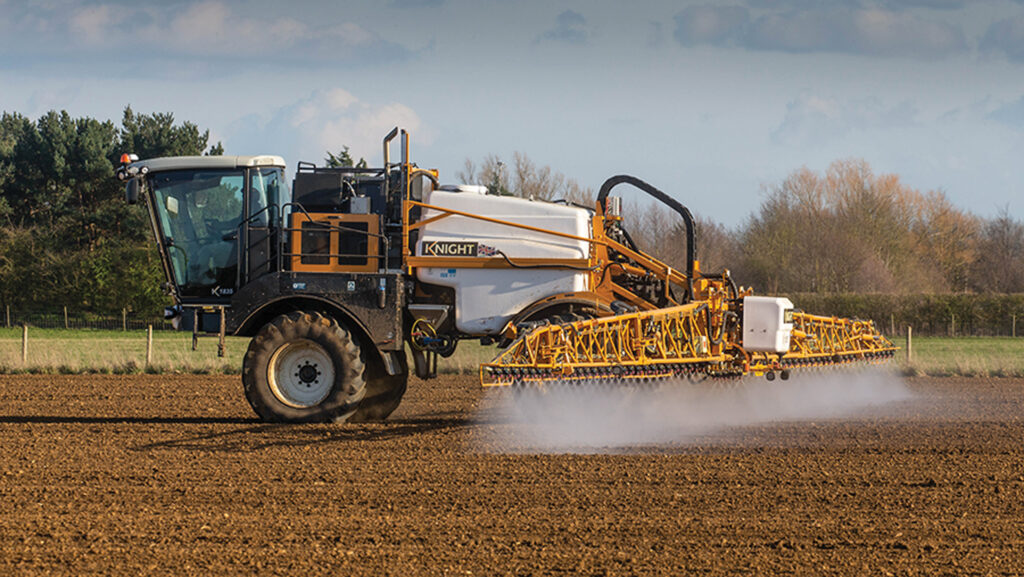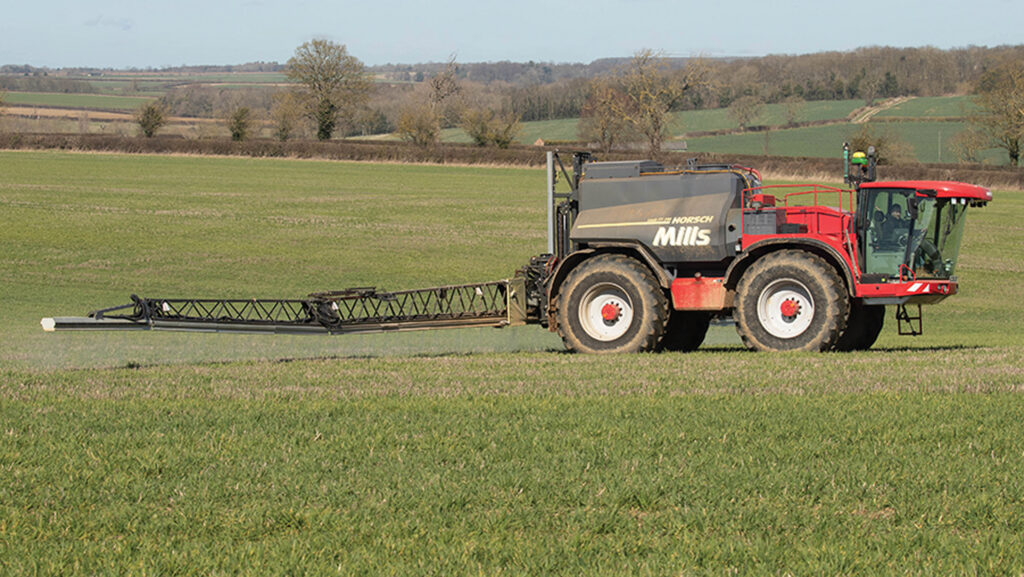Crop Watch: Growers must prioritise pre-ems for spring crops
 © Tim Scrivener
© Tim Scrivener April has arrived with no let up in the showers.
The T0 spray timing has arrived for some earlier drilled wheat crops and farmers are being advised to be aware of the sclerotinia risk as oilseed rape crops start flowering.
Some spring drilling has been carried out over the Easter weekend on lighter land and in areas lucky enough to get a dry window.
However, farmers are being warned that pre-emergence herbicides are a priority, especially for spring beans given the limited post-emergence options and spring barley in higher grassweed pressure situations.
See also: How two farmers are cutting back on fungicides this spring
West
Stephen Harrison
AICC/Southwest Agronomy (Avon)
The change in the month has not brought about the much-anticipated change in the weather. April showers are still the order of the day.
Progress has been made with nitrogen fertiliser applications. Winter barley crops which received their first dose on a couple of dry days in late February have multiplied biomass and look very green.
Brown rust can easily be found, especially in Kingsbarn, and recommendations are in place for fungicides and growth regulators.
Much discussion has occurred regarding growth regulators and impact on straw yields.
An early wet spring with no moisture stress is not the time to be taking drastic action as crops must stand to be harvested efficiently.
If we have extreme dry conditions later, that will be the time to consider changes.
Changes in price of important actives have led to changes in strategy, with fungicide mixtures often more competitive than formulated products.
Winter wheat drilled before mid-November is now at or approaching the start of stem extension. Blackgrass is now at the same stage and prospects of control with contact materials are reducing by the day.
Septoria
Over-wintered septoria is clearly visible in forward crops irrespective of varietal rating. Focus on septoria control will be when final leaf three is three-parts emerged, normally in late April.
A field of wheat following AB15 (legume fallow) has been devastated by wireworm. I worry about the prospects of cropping fields after extended fallow under the Sustainable Farming Incentive (SFI).
There are no chemical control measures for wireworm.
Winter oilseed rape is all over the place both within and between fields, and pigeon grazing has delayed flowering in areas. The timing of mid flowering sprays for sclerotinia will be a challenge.
A few spring barley crops are in the ground and emerged on free draining ground, but these are very much the exception.
Winter beans are gaining leaves, but unfortunately, some very late drilled crops are suffering from corvid attacks.
North
Mary Munro
AICC/Strutt & Parker (Perthshire)
There is very little change in Scottish crops from a month ago. The rain has not been quite as incessant, but it certainly feels as though it has not stopped.
Spotting newly-sown fields is difficult, and the large majority of spring work is yet to start. Most of the winter crops are reasonably on-target with fertiliser applications, and they have greened up and are moving.
The oilseed rape has jumped up, but flowering is late compared with recent years.
I have issued some T0 recommendations for winter wheat, but so far none have been applied.
Similarly, a frenzy of activity composing pre-emergence lines for spring beans and barley has yet to come to fruition in practical implementation.
On the most forgiving soils, there are a few fields here and there that have been drilled as I write, but most growers are catching up with paperwork and waiting patiently.
The news that beans are no longer a minority crop was not helpful. With the “Extensions of authorisation for minor use” guidance rendered null and void, Nirvana (imazamox + pendimethalin) still provides a welcome pendimethalin option.
Some fields for spring barley are targeted for pre-emergence flufenacet + diflufenican to deal with annual meadow grass.
It adds a big cost to the spring barley programme, but the weed is a significant problem in some places.
We are busy with Carbon Audits for farms, who can claim a grant for the preparation of these in 2024. Next year they will be required in order to claim the new Scottish Basic Payment Scheme
Growers can also claim the costs of soil analysis (if it includes a soil carbon or loss on ignition measure) once a Carbon Audit is in place.
We are still waiting for details of the new system, particularly what the level of funding will be.
The uncertainty seems likely to continue to the last minute and I suspect 2025 will be very busy for the industry, adapting to a new regime and drawing up budgets based on something better than guesswork.
East
Becky Finbow
Agrovista (Norfolk/Suffolk)

© Tim Scrivener
A little dry spell has allowed fertiliser applications to be completed and crops to start growing upwards rather than outwards.
With this comes the planning of T0 wheat fungicides. Variety and climate will determine on which fungicide you base your programme.
For example, when it comes to milling varieties such as Skyfall, yellow rust is the predominant issue, so your programme will most likely revolve around tebuconazole.
However, with a feed variety such as Dawsum, septoria is a concern alongside eyespot, so a good T0 would be something containing prochloraz and an azole.
Goodness knows what future weather is going to do, but if it were to turn dry then the crops are going to grow rapidly.
Taming the crop now with a plant growth regulator will help reduce the risk of lodging.
At the moment, mepiquat chloride + prohexadione-calcium (as in Canopy) is my product of choice, as it has been proven to be better in cooler conditions.
I have my first block of spring barley in, so it is finally starting to feel a bit more like spring.
Given the limited post-emergence options for grassweeds, I have made sure to apply a pre-emergence mixture of diflufenican, flufenacet, pendimethalin and tri-allate where grassweeds are a real issue.
Luckily, seed-beds are not as bad as expected, but as I write this at Easter, I know some land is going to be nowhere near dry enough to cultivate just yet.
Talking of pre-emergence, spring beans are starting to be drilled too. This is another crop where there are limited post-emergence options for weed control.
Pre-emergence is therefore vital. Knowing the weed spectrum of the field gives you a better understanding of what would be best to apply. Where cleavers and speedwells are an issue, I recommend clomazone.
With charlock or runch, imazamox will be a key active.
Oilseed rape all over the country is showing us its beautiful yellow flowers, but with it comes the threat of sclerotinia. Warmer nights, moisture and an extended flowering period will increase the risk of infection.
It will pay to keep an eye on AHDB’s risk tool to see areas at high risk and apply a protectant fungicide accordingly.
South
Jamie Swift
Procam (East Sussex)
Never have I known a season to better express the importance of drill date. Identifying growth stages during the spring is of critical importance, which is proving to be tricky of late due to the obvious.
Walking wheats are a mixed bag, with some still to put on tillers and others well into stem extension and approaching growth stage 30.
Crops drilled in good time are showing little disease and will benefit from a dose of nitrogen over an early fungicide.
Especially where drilled later, susceptible varieties such as Zyatt are harbouring high levels of septoria and rust, and are now justifying a T0 application – should growers be able to make it out in the field without too much mess.
A prothioconazole-based mix paired with a multisite will suffice in most instances, but the Easter bank holiday weekend saw yet more rain in the south, so I am conscious of when applications can be carried out.
My takeaway message would be to not bite the bullet and go too early.
Spring drilling
I am pleased to report that some spring crops are now in the ground.
That said, as drills can travel in sporadic windows of opportunity, I am advising that crops are drilled into only acceptable stale seed-beds and that pre-emergence herbicides are prioritised.
A spring crop held back by an early weed burden can see major yield loss, especially as the crop is only in the ground for about 110 days from planting to harvest.
We would all like to have a crystal ball, but I am foreseeing high grassweed pressure throughout the spring, should the weather become more reliable and fields dry out somewhat.
I’m taking no risks when it comes to early weed control.
A pre-emergence spray will be most necessary in blackgrass and ryegrass areas as post-emergence options are very limited, especially with regards to spring barley.
Luxinum plus (cinmethylin) is a very reliable herbicide, but does not have approval on the British Beer and Pub Association brewing list, so in these instances, Bacara Duo (flufenacet + diflufenican) is a strong option.
Oilseed rape crops have sprung into life, with many crops now flowering.
I’m keeping a close eye out for pollen beetle and despite this pest typically becoming an issue at temperatures above 15C, beetles are not hard to find.
I will be monitoring crops closely as a change in weather can quickly lead to spray thresholds being met.

